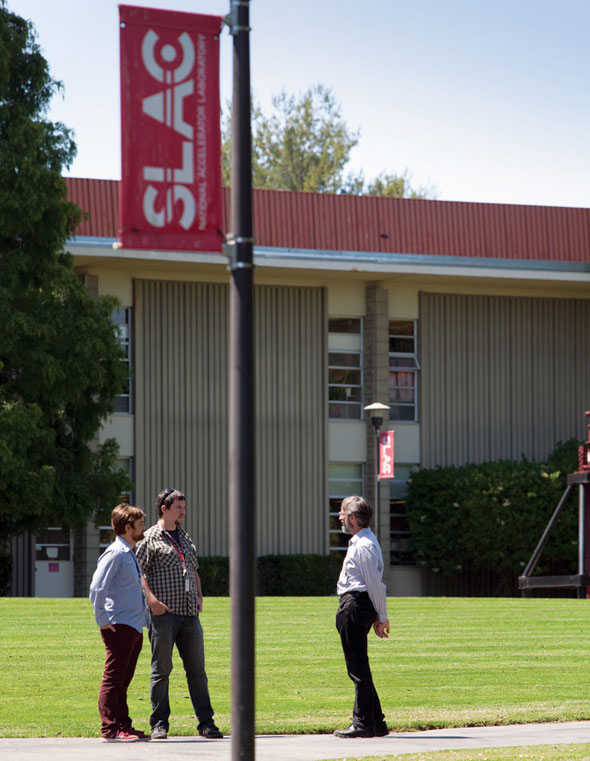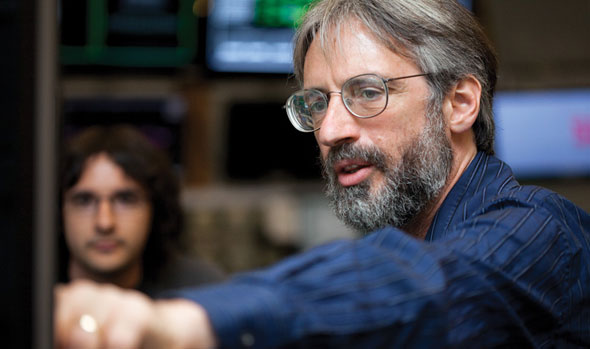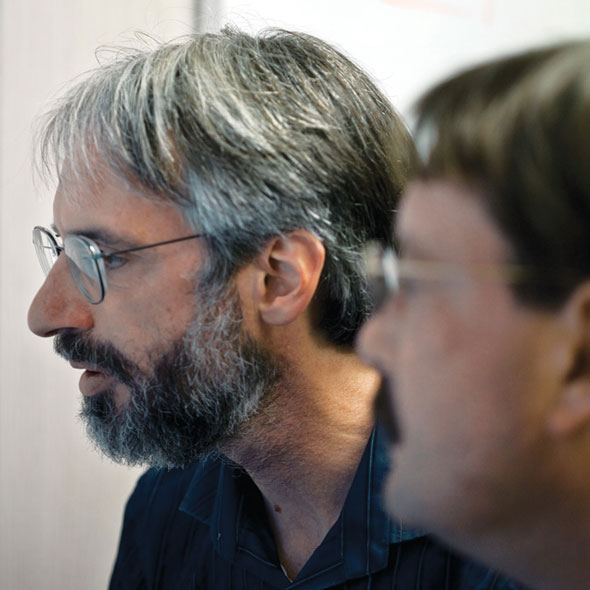Day in the life: Joe Frisch
Go, man, go!
Running the worlds most powerful X-ray laser requires a special intensity
Text by Marissa Cevallos
Photography by Bradley Plummer
Every weekday at 11:45, Joe Frisch pulls himself away from answering emails and strides off the SLAC National Accelerator Laboratory campus for a fast-paced, two-mile-round-trip Death March with a handful of fellow physicists. They cut through parking lots and squeeze past metal fences to a street called Alameda de Las Pulgas, or Boulevard of the Fleas, and pause to decide what to grab for lunch: Mexican food, pizza, or pub grub?
If its pizza, someone declares themselves Pizza Dictator, Frisch says. The dictator decrees the pizza toppings, and the rest of the group has 60 seconds to come up with a better list of ingredients. One good strategy is to wait as long as possible—counting to 59 seconds in your head— to stage a coup for pizza power. But appointing yourself dictator is even better, Frisch says, because your choices will often go uncontested.
His playful strategizing and obsession with numbers might be why his colleagues call him one of the best accelerator scientists at SLACs giant X-ray laser, the Linac Coherent Light Source.
Accelerator scientists play a role thats largely invisible to the public, but crucial for controlling instruments such as the LCLS, the brightest X-ray laser ever built. Its seen as an exciting new tool for probing individual protein molecules, as well as observing super-hot and high-pressure materials like those in the core of a planet. While most of the press attention goes to the experiments that happen at these X-ray hubs and their high-profile results, roughly 150 accelerator physicists and operators work around the clock to keep the laser and other SLAC instruments aligned and running. Its a ship sailing 24 hours a day; when the boat is on course, you hardly notice the crew.
If theres anyone who can keep up with SLACs quick-paced lasers, its Frisch, who thinks, talks, and walks just a bit faster than he can credit to his three cups of coffee a day. On the Death March, he has to remember to look over his shoulder and wait for the rest of the group to catch up. In an 8 a.m. meeting where sleepy-eyed physicists get updates on how the laser behaved through the night, Frisch peppers presenters with questions. Dressed in a blue-striped collared shirt and black jeans, he crosses and uncrosses his legs, twiddles his fingers, and fidgets with a salt-and-pepper beard that looks too grandfatherly for a face that is still boyish at age 47.
On this particular Wednesday, the beam is turned off for 24 hours so scientists can enter and fix any broken parts. That means the minute Frisch walks into the LCLS control room, people flock to him with questions, and hes moving in a flurry from computer to computer to a series of engineers with clipboards.
Today theyre switching out a laser system that shaped the beam into a rectangle, for a simpler system that lets the laser take its desired circular shape. But the move might inadvertently bump up the beams emittance—a measure of how small a space the beam can pack the speeding electrons into. The lower the emittance, the brighter the laser beam. Frisch is concerned the switch might take longer than a day. Hes swapped out laser systems before, and lots of things can go wrong with the optics that have to fine-tune a beam to a point much smaller than a speck of dust. At the meeting, he asks a colleague what time the swap will happen. He wants to be prepared for a call if anything goes wrong. He knows the accelerator systems, says Axel Brachmann, a colleague a few seats away at the morning meeting. He understands them better than most people.
Frisch has two jobs: designing accelerator parts that test how well the laser beam is behaving, and operating the accelerator during shifts. This week, hes the program deputy, a position he dubs the Officer of the Watch, like the temporary captain on a warship. Im on call all the time, he says, after fielding a phone call from an operator at the main control room in the afternoon, pacing his small office and twisting the phones springy cord. Im the fix-it guy. Hes used to midnight emergency phone calls from frantic operators.
Frisch says he was attracted to lasers as an undergraduate at the California Institute of Technology in the early 1980s, when the gravitational wave detector LIGO, which uses lasers to detect tiny changes in gravitational fields, was being conceived. He got his PhD in physics at Stanford University and took a staff job at SLAC in 1990.
I always had a bit of an engineering bent, says Frisch, who often flies his shared 1967 Beechcraft Bonanza commuter plane to Oregon on weekends to hike and scope out volcanoes. The only wall decorations in his office, aside from three shelves of physics textbooks and a Dilbert comic strip, are framed photos of snow-covered mountains rising above clear blue lakes.
Frisch bristles at the job title accelerator physicist. Titles arent relevant here when so many people are crossing into new areas to solve problems on the LCLS, he says; if anything, he should be called an accelerator engineer. Building an accelerator involves gadgets and wires and bulbs, Frisch says. Its like building an airplane. You start from an existing design, which has things like wings and tails that you know, from physical principles, generate lift. Then you ask, what makes it fly better? Its both physics and engineering.
 |
 |
Because accelerator scientists are not under pressure to publish results, Frisch says they can have frank discussions about how to solve problems. Everyone contributes, and no one person can claim to have made the accelerator work, unlike science in an academic setting where scientists race to publish first.
The job keeps him busy—too busy to have children, Frisch admits. He married his college sweetheart, an engineering student who lived down the hall from him at Caltech. She started out in architecture, but is now a defense contractor with the military—Shes either making targets or weapons, Frisch jokes.
Both work hard and play hard, the unofficial creed of their alma mater in Pasadena. They use vacation time to travel to China, Italy, South America, and New Zealand. But at SLAC, Frischs work day stretches from early morning until late at night.
On this particular Wednesday, Frisch stays late. With the days trouble-shooting over, he joins the other scientists at LCLS to take the new laser equipment for a test drive. At 8 p.m., the beam turns on. By 10 p.m., there is a sense of excitement among the physicists in the control room—at least as much excitement as people whod been there for 14 hours could muster, Frisch says. To their surprise, the switch to the new system has not increased the laser beams emittance; in fact, it chopped emittance by 20 percent.
I think its the best weve ever done, Frisch says. Its not often that you make a change like that and its a win in all ways. Usually theres a trade-off.
Improvements like these may not excite the public as much as the biological insights scientists will reap by shining X-rays on protein, or watching movies of how plants churn out energy during photosynthesis. Lots of small steps, however, are what make big projects like the $420 million X-ray laser successful, and what satisfy Frisch at the end of the day.
Im happy when LCLS works, Frisch says, especially if its because of something I did.
 |
 |
 |
Click here to download the pdf version of this article.






